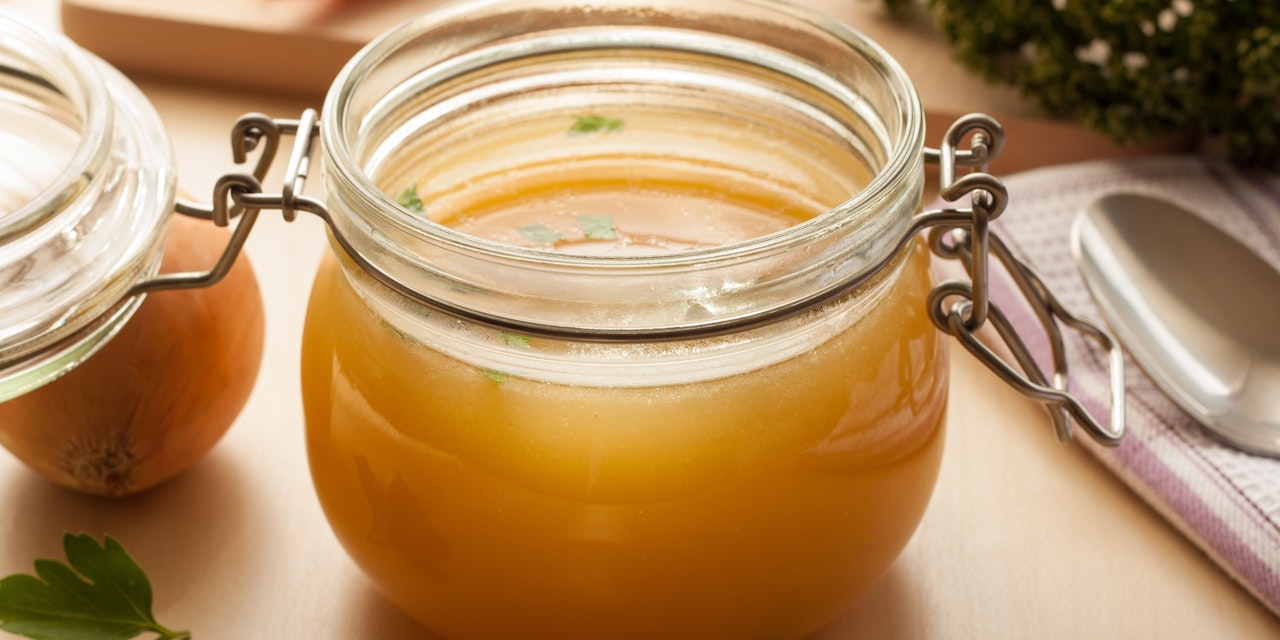All About Bone Broth
Bone broth has been used for centuries for its notable nourishment and nutrition. Learn what research says about its benefits and how to make it.
- Published: 4/27/2022
- 4 min. read

- Published: 4/27/2022
- 4 min. read
Bone broth has been used for centuries for its notable nourishment and nutrition. Fans flock to it for its skin, stomach, and weight regulating benefits. This has created a market for convenient canned, bagged, and powdered versions. But before you start slurping it down, take a look at what the research says about its benefits and if it's better to make your own.
What is bone broth?
Bone broth has been a staple ingredient of meals for ages in various cultures around the world. Bone broth is the liquid created from boiling and simmering animal bones and parts (connective tissue, organs, and meat) in water, usually along with vegetables, herbs, and spices. Bone broth can come from beef, pork, chicken, or fish bones.
Health benefits of bone broth
Gut health
Bone broth can be beneficial for the gut. Even just the warmth can have a calming feeling for our tummies. Bone broth also contains amino acids, or protein building blocks, which can help gut health. Glutamine, for instance, is an amino acid that helps strengthen the gut lining (1). We can also get amino acids from other high-protein meals.
Skin and joints
Bone broth contains collagen, which is a main structural protein found in our skin and connective tissues. Collagen naturally decreases as we age, so it's good to get through our diet (2). Collagen gets broken down into amino acids then is used for body tissues (3), meaning it doesn’t go directly to our joints and skin. Increasing sources of nutrients that help produce collagen, such as vitamin C, support our body in creating it.
Immunity
Mother figures throughout history encouraged us to drink soup to help cure the common cold. Although it can’t “cure” illness, broth can help relieve some symptoms. The warmth can help clear congestion, the easy digestion can be helpful for a stomach flu, and the fluids help prevent dehydration (4). Bone broth is also full of iron, zinc, and selenium, which are essential for our immune system.
Should you make or buy bone broth?
In an ideal world, we would make our own food from scratch. But busy lifestyles and sometimes small spaces make it difficult to dedicate hours of cooking with big pots to prep the perfect broth. The problem is that store-bought broths can be very different from homemade versions - both in flavor and nutrition.
Some research shows a large variability in the amino acid content of bone broth made in non-standardized recipes (5). This makes it an unlikely consistent and reliable source of amino acids. Meaning that it's hard to conclude just how much nutrition is coming from different recipes and commercial brands.
When it comes to products such as bouillon cubes, powdered soups, and canned soups, they often contain excessive amounts of sodium and added sugar. Read the nutritional label in order to find the ones with less sodium, added sugar, and saturated fats.
How to make bone broth
Making bone broth can be pretty easy and healthy. It’s also good for reducing food waste. Whether you have bones from fish, beef, or chicken, you can cook up a tasty broth. Throw in veggies (ones with tough stems work great), dried or fresh herbs. It can also help add a bit of an acidic ingredient such as apple cider vinegar to help break down the amino acids found in connective tissue and collagen.
Ingredients:
- 2 pounds bones (from your choice of meat)
- 1 tbsp apple cider vinegar
- ½ gallon water (2 liters)
- Fresh or dried herbs (garlic powder, thyme, and rosemary work wonderfully)
- Vegetables (optional - try out onion, celery, and carrot)
- ½ tablespoon black pepper
- 1 tablespoon salt
Instructions:
- Put all ingredients in a big pot and bring to a boil.
- Reduce to a simmer and cook for a minimum of a few hours. The longer it cooks, the better it will taste and the more nutrients it will gain. Aim for about 12 hours if possible.
- Once done, let the broth cool (it can help to place it in separate containers).
- Strain soup of the solid ingredients, so just a clear broth is left.
Want more steps to soup up your life? Check out this video for a soup recipe high in immune-boosting zinc (made initially to help us through quarantine times).
Last spoonful
Although research is limited about the benefits of bone broth itself, science suggests that the nutrients in bone broth are both beneficial and health-boosting. Whenever possible, make your own. If you get store-bought, look for the more simple ingredients with less sodium.
What else is bone broth good for? - diets such as the Paleo or keto diet! Give them a try with a comprehensive nutrition app.
All of the content and media on Lifesum is created and published for information purposes only. It is not intended to be used as a substitute for medical advice or treatment. Users should always consult with a doctor or other health care professional for medical advice.
5 references (hide)
All of the content and media on Lifesum is created and published for information purposes only. It is not intended to be used as a substitute for medical advice or treatment. Users should always consult with a doctor or other health care professional for medical advice. If you have or think you are at risk of developing an eating disorder, do not use the Lifesum app and seek immediate medical help.